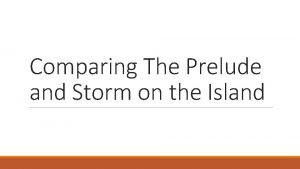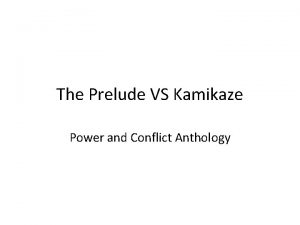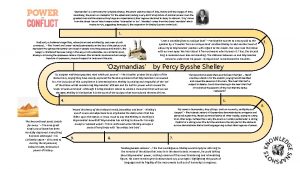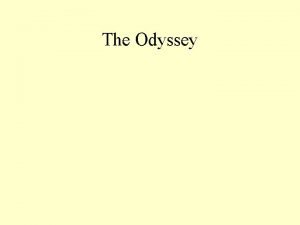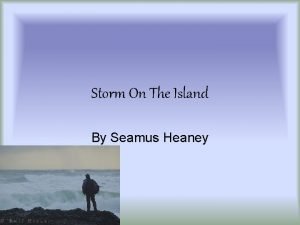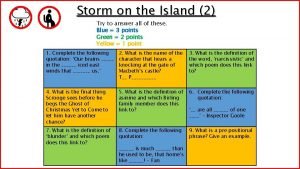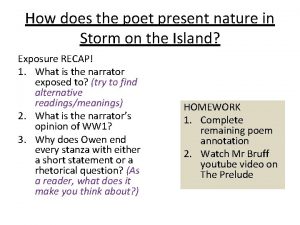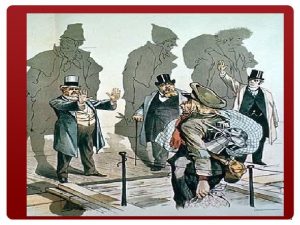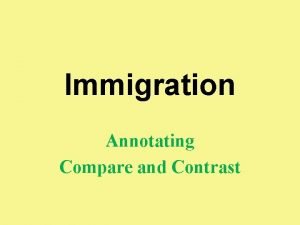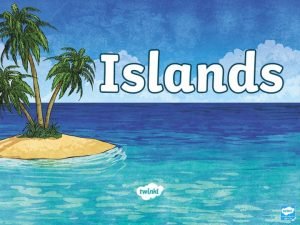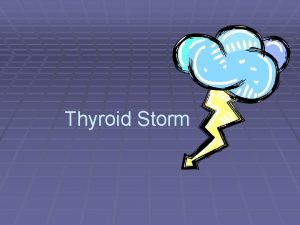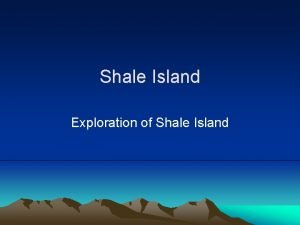Comparing The Prelude and Storm on the Island










- Slides: 10

Comparing The Prelude and Storm on the Island

Similarities and differences • The key theme of both poems is power, as it shows the conflict between nature and man, and that nature always wins. Both poems represent the fear of nature, as shown with the mountain in The Prelude and the storm in Storm of the Island. • Both poems are about mans conflict with nature, however The Prelude shows a spiritual journey of reflection, whereas Storm on the Island suggests that the things we fear have power. • Both poems show that nature is something to be feared, but The Prelude shows that it’s because we offend nature by attempting to manipulate it, whereas Storm on the Island suggests that it’s because we underestimate the violence of nature and its effect on us. • Both poems are about man’s relationship with nature and what we do about it, however The Prelude suggests that man tries to manipulate nature and use it for his own good, whereas Storm on the Island shows how we fear nature and how its power make us weak.

The Prelude • The Prelude is a powerful poem about the power of nature and its conflict with man, and how nature always wins, as man is insignificant compared to nature. • The poem shows the spiritual growth of the poet and how he comes to terms with his place in nature and the world. It represents a spiritual journey to mirror his journey of reflection. • It is part of the ‘romantic movement’ as it is a romantic poem, which believes in the power and beauty of nature. These poems are usually about intense feelings, emotions and personal experiences. • This poem was written as a reaction against the Industrial Revolution and celebrated the natural word.

The Prelude – structure • Written in blank verse. • It’s part of a larger poem that shows the narrators journey, where he encountered a mountain who’s presence had a great effect on him and was troubled by the experience for days afterwards. • Written in iambic pentameter to give a consistent pace. • It’s structured to show the contrast of the serene and peaceful start where the narrator works with nature, to the dark and disturbing battle with nature from when his rowing tries to control his journey.

The Prelude – symbolism • This poem symbolically uses the journey to mirror the narrators spiritual journey of reflection. As the journey continues, it becomes more rough and hostile as the narrator approaches the “huge” mountain, which represents the full might and power of nature, it gets darker and nature becomes harsh and predatory, putting man back in his place. • The conflict between man and nature is caused by mans attempt to manipulate nature, but nature still contains a power and majesty beyond mankind's ability.

The Prelude – learning ladder Grade: 6 7 8 Technique: Effect: Personification of nature Shows that nature cannot be defeated by man as it is more powerful in everyway. Personification of nature Suggests that it knows mans weaknesses because of this, and so can defeat him if he dares to venture too far. Personification of nature The personification of the mountain could symbolise the narrators guilt conscience as he feels he betrayed nature, shown with the oxymoron “troubled pleasure”.

Storm on the Island • Storm on the Island is a powerful poem about the power of nature and peoples fear of the weather. • The poem describes the experience of being in a cottage during a storm. Heaney describes the bare ground, the sea and the wind. The people in the cottage are extremely isolated and can do nothing against the powerful and violent weather. • The narrator admits being afraid by the end of the poem and his experience, by stating "it is a huge nothing that we fear“, which is also an oxymoron. This suggests that the ultimate power of the storm is that it is an unknown quantity. No one knows what the wind will do and what each storm will bring, therefore emphasising our fear of nature.

Storm on the Island – structure • Written in blank verse. • No rhyme and no rhythm. • Conversational tone: -shown with the use if enjambment. -shown with the use of colloquial language such as “as you see”, and “you know what I mean”.

Storm on the Island – symbolism • This poem suggests that there is an ongoing conflict between man and nature, shown with the use of military terms in the poem, such as “salvo”, “strafes”, “bombarded”. • The cottage with “rock” walls on an island represents isolation but also safety. The cottage protects inhabitants from the “savage” weather to show us that we cannot fight nature, as it is too powerful and we would lose. • Harsh imagery is used to portray the weather and its power. This contrasts with the calm tone of the narrator at the beginning of the poem, which undermines its power, suggesting that the weather doesn't scare him.

Storm on the Island– learning ladder Grade: 6 7 8 Technique: Effect: Use of military terms Interesting use of language to describe the weather as violent and dangerous. Use of military terms “Salvo” shows that he compares the wind with human aircraft, using a metaphor to emphasise the power of nature and its control over us to isolate us and fear it. Use of military terms Compares the violence of nature and weather with the violence of war and conflict, and suggests we are at war with nature.
 Storm on the island and the prelude comparison
Storm on the island and the prelude comparison Kamikaze and prelude comparison
Kamikaze and prelude comparison Why is ozymandias a sonnet
Why is ozymandias a sonnet A storm pushes odysseus to the island of the lotus-eaters
A storm pushes odysseus to the island of the lotus-eaters Themes of storm on the island
Themes of storm on the island Storm on the island analysis
Storm on the island analysis Spits like a tame cat turned savage
Spits like a tame cat turned savage Angel vs ellis island
Angel vs ellis island Ellis island and angel island venn diagram
Ellis island and angel island venn diagram What is an island?
What is an island? Island of the blue dolphins map
Island of the blue dolphins map
